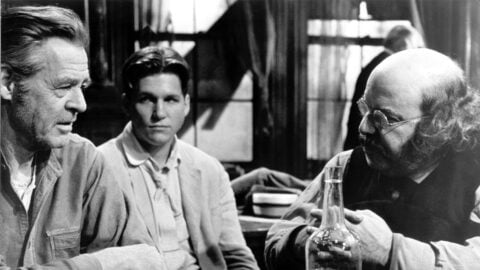Deep Focus: Maps to the Stars

Few actors leap between feats of empathy and masterstrokes of imagination with the offhand brilliance of Julianne Moore. She’s never done it more stunningly than in her back-to-back performances in Still Alice as a linguistics professor with early-onset Alzheimer’s (it just won her the Oscar) and in Maps to the Stars as a Hollywood beauty who panics over aging because she’s an emotional adolescent (it won her the Best Actress prize last spring at Cannes). Moore’s Alice Howland is a meticulous haute-bourgeois woman who derives strength from discipline and convention, but then must struggle against mental deterioration with the same rigor and pride that led her to create an honorable life. Moore’s expressions of this woman’s escalating confusions are all the more potent because Alice is so unapologetically square. You feel that Alice is one of those attractive perfectionists you’ve met all your life in offices and classrooms. Moore renders her heartbreakingly transparent.
In Maps to the Stars, Moore does something more original and exciting. She conjures a terminally willful, insidiously fascinating woman out of Rodeo Drive’s thin air. (In a funny Romney-like moment, she emerges from a store and says she can’t believe that she just spent $18,000.) Moore’s character in Maps to the Stars, middle-aged Hollywood siren Havana Segrand, embodies that grating phrase from a few years ago, “hot mess.” She’s a second-generation Tinseltown catastrophe-in-the-making. Her mother was a glamorous star, Clarice Taggart (Sarah Gadon), who died young, in a fire. Clarice was also a sexually abusive parent, at least according to her daughter. Havana goes public with memories of molestation and tries to purge any lingering traumas with the help of celebrity psychologist Dr. Stafford Weiss (John Cusack), who mingles self-help mumbo-jumbo and Jungian palaver with pummeling massages. Astonishingly, while she is putting herself through primal therapies and public confessions, Havana fights fang and claw for a part her mother played in a 30-year-old movie that’s now being remade as an art film. No wonder Clarice emerges from the vapors to haunt Havana in her bath, pool, and bed and to taunt her as a fantasist and a has-been.
The movie itself is more of a cold mess. Maps to the Stars presents a faux-elegant farrago of sun-kissed Los Angeles depravity. Its cast of bad boys and girls and worse men and women includes a husband and wife who share a mysterious taboo. They’ve funneled their passion into careerism after producing two doomed children, including a brutally cynical, recovering-addict child star who endangers everyone around him, notably his best friend’s sheepdog. (The film tips us to the couple’s secret too early for there to be any great surprise in the “reveal.”) The director, David Cronenberg, creates a tony cheap-thrill atmosphere for damaged people on the make. The screenwriter, Bruce Wagner, piles on profane, portentous subplots as if clicking together dirty Lego bricks. The result is more oppressive than expressive—except for the actors, especially Moore.

You respond to Havana not because you know her—who would know her, except her agent or her publicist?—but because Moore is so magnetic and inventive as a woman who can’t help acting, and acting, on every impulse. Even if you know where Havana is going to end up at the close of a scene, you never know how she’ll get there. All of her emotions are available to her all the time, which may be good for her as an actress, but disastrous for her as a human being, especially because she accesses them with a haphazard sense of occasion. In one dazzling sequence, Havana tries to react appropriately to the announcement that a little boy she met has drowned. But for her, the news is not all bad—it means the boy’s actor mother, out of commission due to shock, will in effect hand Havana a coveted role. It isn’t long before Havana is dancing and clapping at the side of the pool with her personal assistant (or “chore whore”), Agatha (Mia Wasikowska), and cajoling the girl into joining her on the wildly inapt chant, “Na Na Na Na / Na Na Na Na / Hey Hey Hey / Goodbye.”
Moore maneuvers in and out of each emotional hairpin turn lightly, at top speed. She neither satirizes Havana nor doubles down on her pathos, while investing her with her own energy and joy in acting. Havana can play wise or smart and make it stick for a minute or a day, before inevitably giving herself away. She says that the dead boy is “water” and her career’s miraculous upswing is “fire”—doubtless a result of her study of archetypes with Dr. Weiss. Agatha, like Havana’s mother, is a fire victim, with burn scars on her face and body; she moves through the Hollywood heat with long gloves covering her hands and arms. But Havana tells her she’s so beautiful that inside she must look just like… Havana Segrand.
Havana doesn’t know that Agatha is Dr. Weiss’s daughter, estranged from her father ever since she gave her little brother Benjie (Evan Bird) sleeping pills and burned down the family house. She returns from exile in Florida to make amends. Her brother is afraid of her. Her dad and mother (Olivia Williams) will never trust her, especially since she could ignite a scandal that would raze the doctor’s psychobabble empire and stop Benjie’s burgeoning movie career in its tracks.

In 2005, Wagner pegged his years-in-the-making script as “an operatic ghost story.” Havana isn’t the only one who sees dead people and fears death. Benjie has visions of a dying little-girl fan he visited in the hospital because he thought she had AIDS (it turned out to be non-Hodgkin’s lymphoma, which angers him because he doesn’t understand it). He eventually sees the drowned boy Micah, too, though Benjie never met him. Agatha is no ghost, but she does give off a cemetery aura. “I’m very sentimental at the same time as I’m very cold-hearted,” Wagner told LA Weekly’s Brendan Bernhard in a 2005 profile. He left out “moralistic” and “punitive.” In this film, the sins of mothers and fathers destroy daughters and sons.
At a press conference in Cannes, Moore said Maps to the Stars was about characters seeking reasons for their unhappiness outside themselves, instead of looking within. Maybe her belief in that theme enabled her to release the tragicomic potential in what could have been just another tiresome, shallow L.A. “character.” The movie itself says something different about woman’s fate. It catches everybody up in an inherited form of bad karma. For elusive reasons, most of them recite Paul Eluard’s romantic poem, “Liberté.” It’s lovely—the verses include: “On my school notebooks / On my desk and on the trees / On the sands of snow / I write your name.” But their odd sharing of that poem, as well as their parallel conflagrations and hauntings, suggest that these people are victims of fate. The fault really is in their stars, not in their ethics or psyches.
The vitality of the ensemble gives the lie to all this morose fatalism. Cusack emits a malignant force field as Dr. Weiss, who bases his pop eminence on unmitigated confidence. Wasikowska has moments of ethereal poignancy as the daughter turned L.A. waif. Young Evan Bird embodies both the horror and the pathos of a pint-sized monster to whom nothing is sacred. Robert Pattinson is sadly vulnerable as a limo driver and would-be actor and writer. And Moore breaks through the movie’s curdled, knowing façade, having discovered a place for Havana on her own galvanizing seriocomic wavelength. She expands the possibilities of a woman with very few internal resources.

Cronenberg’s detached, ominous style, both formalist and fungoid, allows you to laugh at some cold-blooded humor, like Benjie telling the dying fan that people don’t realize that his big hit, Bad Babysitter, grossed $780 million worldwide. But Cronenberg’s mannerist cinema suits Wagner’s chic volatility too perfectly. (Wagner’s 1993 TV miniseries, Wild Palms, a more eclectic, sweeping and amusing precursor to Maps to the Stars, frequently referenced Cronenberg’s 1983 movie Videodrome.) “I infect my work with madness, then let it settle,” Wagner told Bernhard. “The story is infected by something — like in David Cronenberg’s films. My job is to be realistic and poetic at the same time, so that people have a sense of being transported somewhere else.” But Maps to the Stars is a trip to nowhere—maybe that’s where these filmmakers think nihilism meets the Buddhist tenet of letting go. For Cronenberg and Wagner, it’s a suicidal folie à deux.







